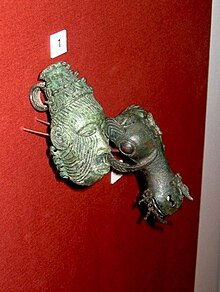A Typical African Village In The 9th And 10th Century

By Okechukwu Okugo
Africans, from primordial times, were never lazy people. Each day surrounding the hub of activities in the home, were jobs which required physical strength to actualize.
Both men and women needed to accomplish a lot of physical tasks lest their families would die of hunger or starvation.
For example considering a typical African man in those days, either he's in one of his large acres of farmland with his family cultivating food crop/cash crop; or he would be seen climbing the palm tree to tap the wine or harvest the ripe palm fruits.
The palm tree's one of the most important food/cash crops, considering the role its products played in the society.
Palm oil is harvested from it. The distinctive red color of African food comes from the use of palm oil in cooking. Almost all African food is cooked with it.
The African man also relied on the palm tree to produce some of his building materials. Example was the use of palm leaves for roofing, the palm rachis was used for making hut poles, rafters and also used in making some of their local furniture e.g bed.
They tapped the palm tree by making a special cut at the base of the stem on the palm tree and position a calabash or container to collect the sap, which they'd climb every morning and evening to retrieve filled calabash.
It was no insignificant task climbing the palm tree everyday, or accomplishing all the home and farm jobs facing the natives.
Hardworking African man coming down from a palm tree, with his tapped palm wine in a calabash hung at his left hand side, in the middle of a compound
Photo credit: easyscienceforkids.com
An African man with a head of palm fruits cut down from a palm tree
Besides making from palm kernel, a nut inside the palm fruit, special oil that can be used as a soothing balm on the skin and also for hair, the women manufactured brooms from the palm tree. They made soap, hairbrush, and other products from it.
Even when the palm trees were cut down, the women and their children harvest from the decaying tree trunk edible insects and mushroom.
The kitchen job is no less a job either. Every African woman requires a great deal of industrious domesticity to feed her children.
In the kitchen, the mortar and pestle is one of the most important items because it is the major food blender or processor.
90% or more of African food is processed by pounding. Ranging from corn, millet, yam, cassava to ingredients like crayfish, pepper and numerous spice nuts like nutmegs etc.
Then, usually, African families were most times extra large. And for a large family, the pounding of enough yam or cassava meal (fufu) for the entire household everyday is no petty task.
This meal is a staple in many African society.
Also the manual harvesting of the oil from palm fruits was a very nerve-racking one. After cooking the palm fruits well, it would be pounded in a mortar vigorously for many hours and the oil strenuous to retrieve.
Family preparing food with mortar and pestle
Industrious African woman performing her regular daily task
Three women showing that from young age, African women had always been industrious in the home front (pounding a food item in a mortar and pestle)
Pounding boiled yams in a mortar and pestle to prepare a pounded yam meal. Pounded yam is not eaten alone, rather it would always serve as an accompaniment for numerous African soups
Pounded Yam With Egusi (Melon) Soup
Making Ethiopian coffee with mortar and pestle
In this 9th or 10th century African village, especially in Igbo-Ukwu, today a town in the Nigerian State of Anambra, southeastern part of the country, there were highly skillful craftsmen, combining successfully, their daily strenuous task of providing for large families with the making of complex bronze castings with sophisticated technical finishing.
Igbo-Ukwu craftsmen were the earliest artistic metalworkers of copper and its alloys in West Africa.

Human and ram's head pendants from Igbo-Ukwu crafted around 9th and 10th century; displayed in the British Museum

9th century Igbo-Ukwu bronze ceremonial staff head in the British Museum
In a typical African village, Igbo-Ukwu in southeastern Nigeria, as early as 9th century, metalworking craftsmen existed
Bowl on a Stand; 9–10th century
Presumed from Igbo Isaiah, Igbo-Ukwu
Leaded bronze; H. 8 in. (20.3 cm)
National Museum, Lagos, Nigeria (39.1.1)
Photo © Dirk Bakker



Comments